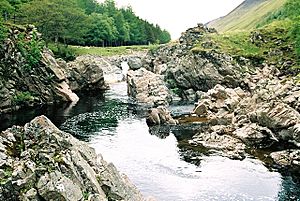Glen Tilt facts for kids

Glen Tilt (which is Gleann Teilt in Scottish Gaelic) is a beautiful valley, called a glen, located in the very north of Perthshire, Scotland. It starts near Aberdeenshire and mostly goes southwest. But for the last 4 miles, it turns straight south until it reaches Blair Atholl.
The Tilt River flows through the glen for about 14 miles. It joins the Garry River. Along the way, the Tilt River gets water from the Tarf River on its right side. The Tarf River has some lovely waterfalls just before it meets the Tilt. On the left side, the Fender River also has some pretty falls.
A long time ago, in 1847, a powerful person named George Murray, 6th Duke of Atholl tried to stop people from using the glen. However, the Scottish Rights of Way Society successfully fought for the public's right to access the glen. This was an important moment for public access to land in Scotland.
The huge mountain of Beinn a' Ghlò stands tall over the lower eastern part of the glen. This mountain has three main peaks, known as Munros. These are Càrn nan Gabhar (1129 meters high), Bràigh Coire Chruinn-bhalgain (1070 meters high), and Càrn Liath (975 meters high).
Contents
Glen Tilt's Amazing Rocks and Geology
Glen Tilt is famous for its rocks. Sometimes, good quality Marble is dug up here. The way the rocks are formed has always interested geologists, who are scientists who study the Earth's rocks and history.
James Hutton's Discovery
One of the most famous geologists to visit Glen Tilt was James Hutton. He came to the glen in 1785. Here, he found large rocks with granite pushing into other types of rocks called metamorphic schists.
Hutton saw that the granite had been melted when it pushed into the schist. This was a very important discovery! It showed him that granite forms when hot, melted rock cools down.
Challenging Old Ideas
At that time, many scientists believed in an idea called Neptunism. This idea said that all rocks, including granite, were formed by chemicals settling out of water. Hutton's discovery in Glen Tilt proved that granite formed from molten rock, which went against the Neptunism idea.
He realized that the granite must be younger than the schists it pushed into. This finding helped Hutton create his own theory, called Plutonism. This theory explained that rocks like granite are formed from heat deep inside the Earth.
Understanding Earth's Long History
Hutton's work in Glen Tilt was one of the key pieces of evidence that led him to develop the idea of an incredibly long geologic time scale. He famously said that Earth's history showed "no vestige of a beginning, no prospect of an end." This meant that Earth's history was far, far older than people had previously thought.
Sir John Clerk of Eldin also visited this site. He made detailed drawings of the geology near where the old Dail-An-Eas Bridge used to be. The bridge has since fallen down, but its old supports are still there and are considered a protected historical site.
Royal Visit to Glen Tilt
Glen Tilt has even had a royal visitor! Mary, Queen of Scots came to the glen in August 1564. She wrote a letter from a place called "Lunkartis in Glentilth" to her friend and ally, Colin Campbell of Glenorchy.
Images for kids
-
George Washington Wilson's August 1885 photograph of the Glen Tilt looking upstream toward Forest Lodge
See also
 In Spanish: Glen Tilt para niños
In Spanish: Glen Tilt para niños




